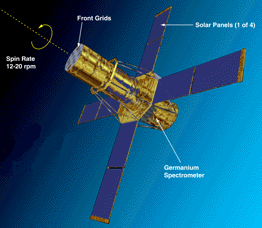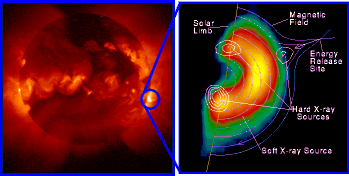|
|
|
Other RHESSI |
|
|
|
|
|
|
|
|
|
|
|
|
|
HESSI: Studying the Fundamental Aspects of Solar Flares |
|
|
What is a Solar Flare?Solar flares and the often associated coronal mass ejections are the biggest explosions in today's solar system. Sometimes they have as much energy as a billion megatons of TNT, several orders of magnitude more than the energy of the recent crash of Comet Shoemaker-Levy into Jupiter. This tremendous amount of energy is typically released in only a few minutes. Plasma is heated to tens of millions of degrees and electrons, protons, and heavy nuclei are accelerated to near the speed of light. Some of these particles stop in the solar atmosphere and produce the observed X-ray and gamma-ray emissions. Other particles travel outward from the Sun and are detected in the vicinity of the Earth and beyond. Where Does the Energy Come From?It is believed that the energy of a solar flare comes originally from the violent motions below the solar surface. Prior to a flare, it is thought that energy builds up from below and is stored in the magnetic field that pervades the solar atmosphere. This usually occurs near a sunspot, but exactly how it happens and what triggers it to be suddenly and explosively released is not known. Why Study Solar Flares?
Why Study Solar Flares Now?The occurrence rate of solar flares varies on an 11-year cycle as illustrated below, where the number of flares recorded per month is plotted versus time for the last two cycles. The dotted line shows the predicted rate for the current cycle based on a simple average of the previous two cycles. Most flares, particularly the rare, large bursts with the most dangerous effects, occur within two to three years of the peak in the 11-year cycle. HESSI will take full advantage of the current peak in the solar activity cycle with up to three years of flight operations beginning in the year 2001. HESSI will make observations during the next maximum in solar activity
The High Energy Solar Spectroscopic ImagerWhat Questions will HESSI Address?
|
How will HESSI Address these Questions?
HESSI, shown below, will concentrate on electrons and protons accelerated in solar flares through observations of the X-rays and gamma rays that they produce:
| HESSI will obtain the first ever X-ray and gamma-ray images of flares from 100 keV to 20 MeV. | |
| HESSI will do the first ever nuclear gamma-ray line spectroscopy of solar flares. | |
| HESSI will obtain pictures of flares in X-rays with an angular resolution of 2 arcseconds, a factor of three better than previously possible. | |
| HESSI will measure X-ray and gamma-ray spectra with less than 1 keV energy resolution, a factor of 20-40 better than previously possible with scintillation counters. |
Artist's concept of HESSI mounted on a spinning spacecraft
![]()
What Effect Does Solar Activity have on Earth?
Episodic solar activity, including flares and coronal mass ejections, has a number of terrestrial effects:
| Energetic particles are hazards to astronauts and satellites. | |
| Geomagnetic disturbances may damage power systems and disrupt communications on the Earth. |
What Does a Solar Flare Look Like?
Full Disk of the Sun and a Flare as seen in X-rays
The picture of the Sun that is shown here was taken with the Soft X-Ray Telescope on the joint Japan-U.S. Yohkoh mission. It shows the solar atmosphere at a temperature of about 2 million degrees glowing in soft X-rays. The diagram on the right is a blow-up of a flare, inside the blue square, as seen with Yohkoh in soft and hard X-rays. The soft X-rays shown in color are from plasma heated during the flare to temperatures of 10-20 million degrees. The plasma is constrained to the loop-like shape by the magnetic field shown schematically by the blue lines. The hard X-ray sources shown by the white contour lines are from the electrons accelerated during the flare. The possible site of the original energy release is indicated high in the corona.
How are X-rays Produced in Solar Flares?
The X-rays are believed to be produced by the electrons accelerated in the solar corona during the flare. As the electrons travel at velocities about one third the speed of light in the corona, a small fraction of them (1 in 100,000) suffer close encounters with the ambient protons, as indicated below. In such an interaction, the electron is attracted towards the proton as a result of the opposite charges, and its path is bent. An X-ray photon is produced at the point of the electron's closest approach to the proton. This is known as bremsstrahlung, from the German word meaning braking radiation. By detecting these X-ray photons with HESSI, scientists will be able to determine where and how many electrons are accelerated and to what energies.
Production of X-rays in solar flares
How are Gamma Rays Produced During Solar Flares?
Just as electrons are accelerated during solar flares, free protons and the nuclei of heavier elements in the solar atmosphere are also accelerated. Some accelerated protons encounter the nuclei of carbon, oxygen, neon and other elements found in the solar atmosphere. When a proton collides with one of these nuclei, the nucleus is excited to a higher energy level. The excited nucleus gives off a gamma-ray photon with a specific energy characteristic of the element involved and returns to its original energy level or ground state. Alternatively, an accelerated heavy nucleus can interact with an ambient low-energy proton and become excited to a higher energy level. It continues on at a similar velocity and emits the characteristic gamma ray as it decays back to the ground state. Because of the velocity of the heavy nucleus, the gamma-ray energy is Doppler shifted up or down, depending on whether the nucleus is moving towards or away from the observer, respectively. The process is illustrated below.
Production of gamma rays in solar flares
![]()
New Technology being Developed
| Fine grids have been fabricated using new, innovative technology for Fourier-transform imaging in X-rays and gamma rays. | ||||||||||||||||||||||||||||||||||
 Tungsten
and Molybdenum grids developed by Thermo
Electron Tecomet (34 micron pitch, 25 microns thick, 60 mm diameter) Tungsten
and Molybdenum grids developed by Thermo
Electron Tecomet (34 micron pitch, 25 microns thick, 60 mm diameter) |
||||||||||||||||||||||||||||||||||
 Tungsten grid developed by Delft
University of the Netherlands. Tungsten grid developed by Delft
University of the Netherlands.(98 micron pitch, 3 mm thick, 130 mm square) |
||||||||||||||||||||||||||||||||||
Tungsten grid being fabricated using wire electric discharge machining for the High Energy Imaging Device (HEIDI), flown on a high-altitude balloon in June, 1993. (1250 micron pitch, 10 mm thick, 144 mm in diameter) |
||||||||||||||||||||||||||||||||||
|
Ground-based Observations to Complement HESSIGround-based radio and optical solar observations will provide complimentary flare observations to reveal other information about the hot plasma and the accelerated electrons. |
| New-technology fine grids for X-ray imaging | |
| Low-altitude (600 km) orbit to eliminate need for shielding | |
| Single science instrument weighing only 120 kg | |
| New start to launch in 3 years | |
| Launch in 2001 in time for solar maximum | |
| Simple spinning spacecraft | |
| Simple flight operations | |
| Low-cost, ground-based radio and optical observations | |
| Focussed mission on high energy aspects of solar flares | |
| First ever X-ray and gamma-ray imaging from 100 keV to 20 MeV | |
| First ever gamma-ray spectroscopy to resolve nuclear lines | |
| Improved spatial, spectral, and temporal resolution at all X-ray and gamma-ray energies from 3 keV to 20 MeV |
![]()
Related WWW Locations
| HESSI Home Page | |
| Solar Flare Theory Home Page | |
| Solar Connections Home Page | |
| Solar Data Analysis Center Home Page | |
| NASA WWW home page |
![]()
Usage Statistics for the Hesperia Server
Weekly hits on the HESSI Home Page and Online Brochure
![]()







